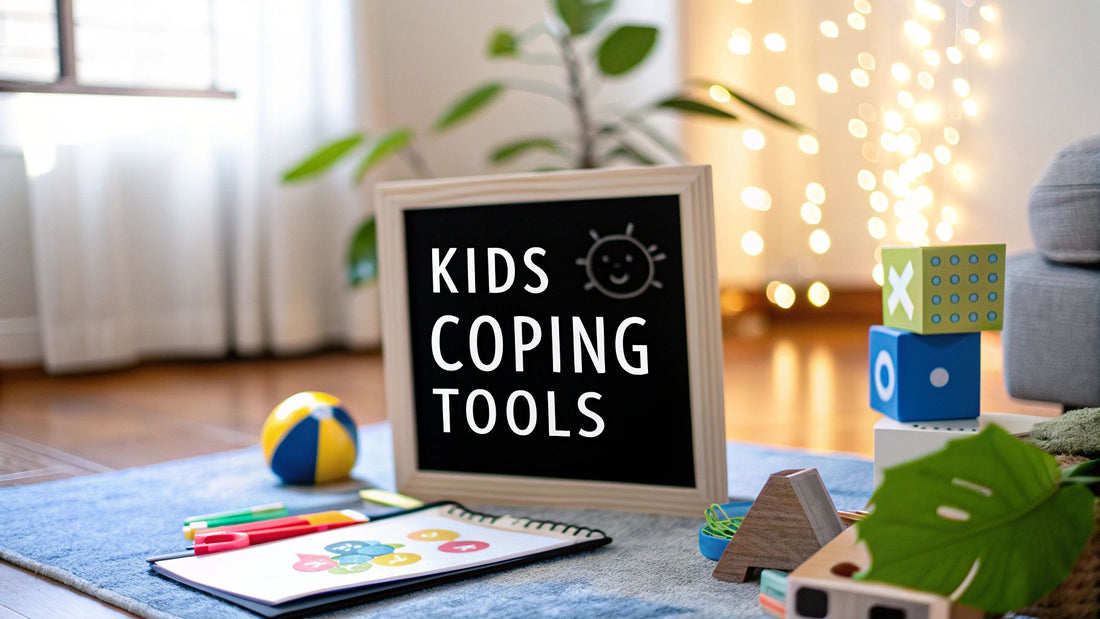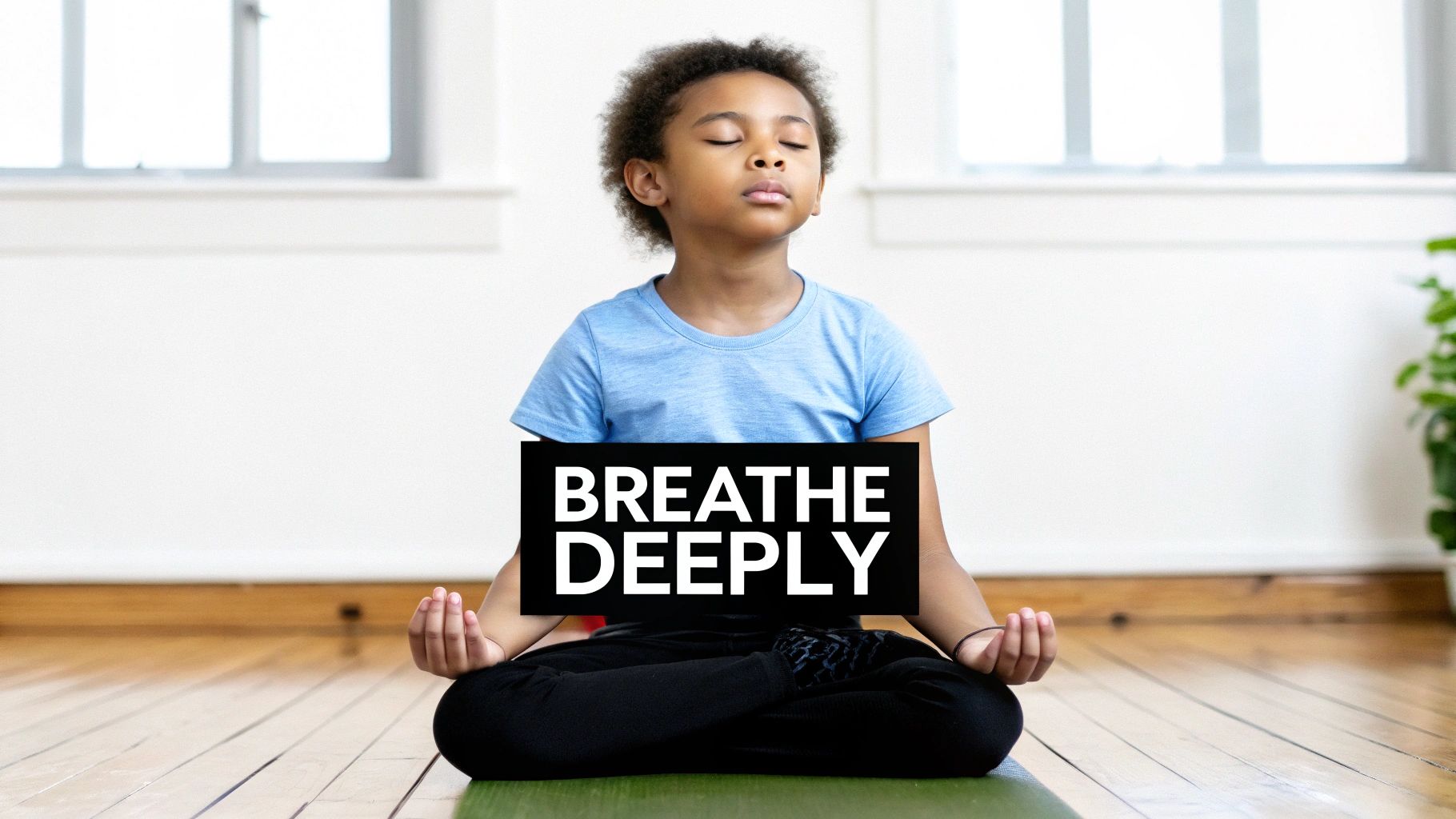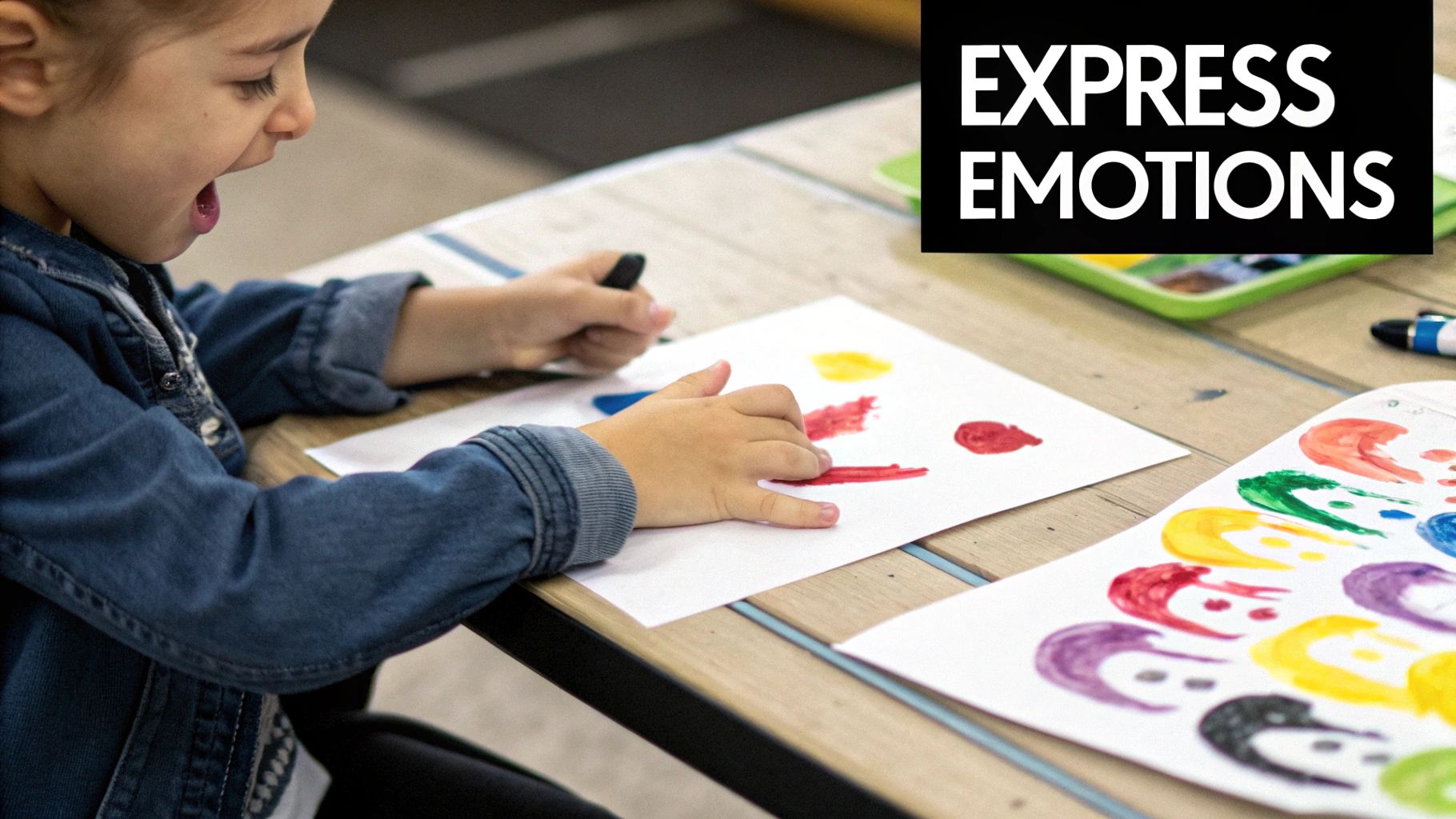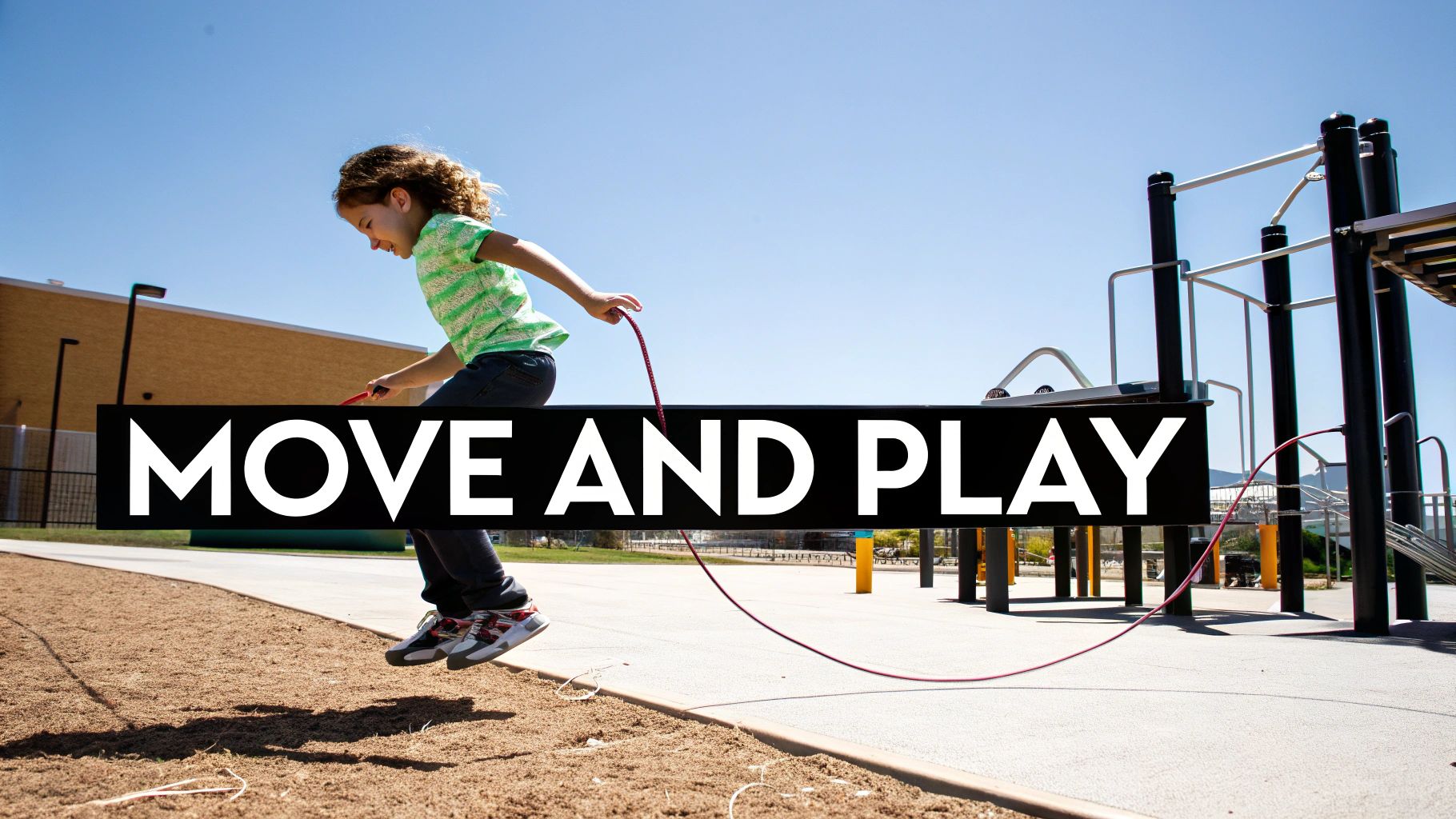
8 Essential Coping Strategies for Children
Share
In today's fast-paced world, children face a unique set of challenges. From the pressures of social media to academic expectations, their mental resilience is constantly tested. Recent statistics reveal a concerning rise in mental health issues among young people in the UK, with one in six children aged 7 to 16 having a probable mental health problem. This trend underscores the urgent need for supportive tools at home and in school. The issue extends beyond personal wellbeing, with poor mental health costing UK businesses up to £56 billion annually in lost productivity, highlighting the long-term societal impact of not addressing these issues early.
This article is designed as a practical resource to equip parents, carers, and educators with effective coping strategies for children. We will move beyond generic advice to explore a curated list of research-backed techniques, including mindfulness exercises, creative expression, and problem-solving skills. Each section offers practical examples and straightforward, actionable steps to help you build a child's emotional toolkit.
While the strategies discussed are invaluable for fostering resilience, it's crucial to remember that I am not a mental health professional and this guide is not a substitute for professional medical advice. If you have serious concerns about a child's mental health, please consult a GP or a qualified mental health professional for guidance. Now, let's explore these practical methods for nurturing a more resilient generation.
1. Deep Breathing and Mindfulness Exercises
One of the most powerful and accessible coping strategies for children is learning to use their own breath to calm their nervous system. Deep breathing and mindfulness exercises teach children to anchor themselves in the present moment, offering an immediate tool to manage overwhelming feelings like anxiety, anger, or frustration. This technique works by activating the body's parasympathetic nervous system, which signals the brain to relax, slow the heart rate, and reduce the physical symptoms of stress.

Pioneered in therapeutic settings by figures like Jon Kabat-Zinn, these practices are now widely integrated into schools and homes. Many schools have adopted 'mindful moments' before lessons, finding it improves focus and reduces classroom disruption. Similarly, paediatric hospitals often guide children through simple breathing exercises before medical procedures to ease their fear. The key is making it engaging and age-appropriate.
How to Implement Breathing Exercises
- Make it Playful: Frame breathing as a game. Try "bunny breaths" (three quick sniffs in, one long breath out) or "snake breaths" (a long, hissing exhale). Another popular one is "hot chocolate breathing": pretend to hold a mug of hot chocolate, breathe in the chocolatey smell, then blow out gently to cool it down.
- Use Visual Cues: Ask your child to lie down and place a favourite stuffed animal on their belly. They can watch it rise and fall with each deep breath, helping them focus on the physical sensation.
- Practise When Calm: Introduce these techniques during quiet, happy moments, not just during a meltdown. This builds familiarity and positive association, making it easier for them to recall the skill when they're upset.
- Create a 'Calm Corner': Designate a cosy space in your home with soft cushions, sensory toys, and perhaps some mental health-themed apparel like a weighted hoodie, where your child can go to practise their breathing when they feel overwhelmed.
By modelling this behaviour and practising together, you can normalise it as a healthy response to stress. Making mindfulness a part of your family's routine is an invaluable step in building emotional resilience.
2. Emotional Expression Through Art and Creativity
When children lack the words to describe their big feelings, creativity offers a powerful alternative language. Using artistic mediums like drawing, painting, sculpting, or even music, children can process complex emotions, communicate internal struggles they can't verbalise, and develop a healthy outlet for stress. This coping strategy allows them to externalise their feelings, making abstract emotions like sadness or anxiety tangible and more manageable.

Pioneered by figures like Edith Kramer in the field of art therapy, this approach is now a cornerstone of child mental health support. Many children's hospitals and mental health centres utilise art therapy to help young patients cope with illness or trauma, while schools have integrated expressive arts to support emotional wellbeing. The focus is never on the artistic skill but on the act of creation itself as a form of release and self-discovery.
How to Implement Creative Expression
- Offer a Variety of Materials: Provide a range of supplies like crayons, paint, clay, and collage materials without pressure to use them in a specific way. The freedom to choose is part of the process.
- Focus on Process, Not Product: Emphasise that there is no "right" or "wrong" way to create. The goal is to express, not to make a masterpiece. This removes pressure and encourages authenticity.
- Ask Open-Ended Questions: Instead of asking "What is it?", try "Tell me about your creation." This invites your child to share the story or feeling behind their art without judgement. For parents seeking more avenues for creative expression, consider these specific drawing ideas for children.
- Use Gentle Prompts: If a child is stuck, you can offer prompts like "Draw what your anger looks like" or "Create a sculpture of your safe, happy place." Understanding how to link colours with feelings is also a valuable skill, and you can learn more about colouring emotions.
By creating a dedicated, judgement-free space for art, you provide a consistent and reliable tool for emotional regulation. Making creative expression a regular part of your routine can be a foundational element in building a child's emotional resilience.
3. Physical Exercise and Movement Activities
Channelling difficult emotions into physical activity is one of the most effective coping strategies for children. Movement helps children release pent-up energy and tension, while also triggering the release of endorphins, the body's natural mood elevators. This process reduces stress hormones like cortisol and helps to regulate the nervous system, offering a healthy outlet for feelings that may be too big to express with words.

This principle is supported by extensive research from figures like Dr John Ratey, who highlighted the profound link between exercise and brain health. Many schools now integrate 'brain breaks' with short bursts of activity between lessons, leading to improved concentration and fewer behavioural issues. Similarly, specialised programmes like therapeutic horse riding or martial arts are used to help children process trauma and develop emotional control, showing how movement can be a powerful tool for healing and building resilience.
How to Implement Movement Activities
- Match it to Their Interests: Tailor the activity to what your child enjoys. This could be anything from dancing to their favourite music in the living room to kicking a football in the park or trying a martial arts class.
- Create a Daily Routine: Weave movement into your daily schedule, rather than saving it for moments of crisis. A regular after-school walk or a weekend family bike ride makes physical activity a normal and expected part of life.
- Offer Variety: Provide both individual and social options. Some children may need to run around alone to decompress, while others will benefit from the connection of a team sport or a group game. For more inspiration, explore a range of engaging kids' mental health activities.
- Keep it Fun: Focus on playfulness over performance. For example, have a "silly dance" competition where the goal is to be as goofy as possible, or turn a walk in the park into a scavenger hunt. This keeps activities light-hearted and enjoyable.
By encouraging regular movement, you provide your child with an essential tool for managing their emotional well-being throughout their life. It teaches them that they have the power to change how they feel by actively engaging their body.
4. Problem-Solving and Cognitive Restructuring
Empowering children with problem-solving skills and the ability to reframe negative thoughts is a cornerstone of emotional resilience. Problem-solving and cognitive restructuring are coping strategies for children that provide a systematic way to tackle challenges, from friendship squabbles to homework frustration. This cognitive-behavioural approach teaches them to move beyond reactive emotions and engage in constructive, critical thinking, helping them develop a more balanced and optimistic outlook.

Pioneered by figures like Dr Aaron Beck, these techniques are central to many evidence-based therapies for anxiety and depression in young people. Schools have integrated these ideas into curricula through 'Stop, Think, Act' frameworks and peer mediation programmes that teach structured conflict resolution. The goal is to equip children with a mental toolkit they can use independently when faced with a difficult situation, reducing feelings of helplessness and building self-confidence.
How to Implement Problem-Solving and Cognitive Restructuring
- Use Visual Aids: Create a 'problem-solving wheel' or a step-by-step chart that guides your child through identifying the problem, brainstorming solutions, and choosing one to try. This makes the abstract process concrete.
- Practise with Low-Stakes Issues: Start by working through simple, everyday problems, like deciding how to share a toy or what to do on a rainy afternoon. This builds their skills in a calm, controlled environment.
- Identify 'Thinking Traps': Help your child recognise unhelpful thought patterns, such as "catastrophising" (expecting the worst) or "all-or-nothing" thinking. For instance, if they say "I can't do my maths homework, I'm rubbish at it," you can help them reframe it to "This maths problem is tricky, but I can try one question at a time."
- Role-Play Scenarios: Act out different challenging situations and practise generating and testing solutions together. This helps build their confidence and provides a safe space to explore different outcomes.
By teaching children to challenge their negative thoughts and approach problems systematically, you are giving them a powerful, lifelong coping strategy. This proactive approach not only helps manage immediate distress but also fosters a mindset of capability and resilience that will serve them well into adulthood.
5. Social Support and Communication Skills
Teaching children to build and lean on a support network is one of the most vital coping strategies for children, fostering long-term resilience. This skill involves more than just having friends; it's about learning to effectively communicate needs, ask for help, and offer support to others. When children understand how to connect with trusted individuals—and manage their online interactions wisely—they are less likely to feel isolated by their problems. This is especially important in an age where social media can significantly impact mental health, creating pressures around comparison and validation.
This approach is championed by resilience research and is foundational to organisations like Big Brothers Big Sisters. These models demonstrate that a strong network of caring adults and peers acts as a powerful buffer against stress and adversity. In schools, peer support programmes where older students mentor younger ones have been shown to improve both parties' wellbeing and sense of belonging. The core principle is that connection is a fundamental human need and a powerful tool for emotional regulation.
How to Implement Social Support and Communication
- Identify a 'Trusted Adult' Network: Help your child create a visual map or list of their "go-to" people. This could include parents, grandparents, teachers, or coaches. This makes the concept of a support system tangible.
- Role-Play Social Scenarios: Practise conversations for difficult situations, such as asking a teacher for help with homework or telling a friend their feelings were hurt. A practical example could be scripting: "I felt sad when you didn't save me a seat. Next time, could you?"
- Teach How to Ask for Help: Frame asking for help as a sign of strength, not weakness. Differentiate between tattling (getting someone in trouble) and reporting (getting someone out of trouble).
- Create Opportunities to Help Others: Encourage acts of kindness, like making a card for a sick classmate or helping a sibling with a task. Giving support is just as important for building empathy and self-esteem as receiving it is.
Developing these skills is a key part of teaching kids emotional intelligence, providing a foundation for healthy relationships throughout their lives. By nurturing their ability to connect, you give them a resource they can turn to long after they have left home.
6. Routine and Structure Development
Establishing predictable routines and clear structures is a cornerstone of building emotional security for children. When a child's world feels chaotic or overwhelming, a consistent daily rhythm provides an external sense of order that helps them feel safe, grounded, and in control. This strategy is particularly effective for managing anxiety and behavioural challenges, as it reduces uncertainty and makes daily expectations clear.
This approach is championed by frameworks like Positive Behaviour Interventions and Supports (PBIS) in schools and is a key component of trauma-informed care. Trauma-informed schools, for example, implement highly consistent daily schedules to create a safe harbour for children who may lack stability elsewhere. Similarly, therapeutic settings use structured routines to help children regulate their emotions and behaviours, proving its value as one of the most reliable coping strategies for children facing adversity.
How to Implement Routine and Structure
- Create Routines Together: Involve your child in planning their daily schedule. This gives them a sense of ownership and makes them more likely to follow it. Ask for their input on morning, after-school, and bedtime routines.
- Use Visual Aids: For younger children, visual timetables or charts with pictures can make the routine easier to understand and follow. Timers can also be a helpful, neutral way to signal transitions between activities.
- Start Small and Build: Introduce one or two simple routines first, such as a consistent bedtime process. A practical example is: bath, pyjamas, story, then lights out at the same time each night. Once that is established, you can gradually add more structure.
- Balance Structure with Flexibility: While consistency is key, it's also important to teach children how to adapt. Build in some flexible time and model a calm response when plans inevitably change.
By providing a predictable framework for their day, you are not just managing behaviour; you are giving your child a powerful tool for self-regulation. Acknowledging their effort to follow routines reinforces their sense of capability and stability.
7. Relaxation and Self-Soothing Techniques
Teaching children various methods to self-soothe and relax is fundamental to building their emotional toolkit. These techniques focus on activating the body's natural relaxation response, calming the nervous system and helping to manage overwhelming emotions before they escalate. By learning to self-regulate, children gain a powerful sense of control over their feelings, a key component of lifelong mental well-being.

Pioneered by figures like Dr Edmund Jacobson with progressive muscle relaxation, these strategies are now widely endorsed by child psychologists and integrated into many supportive settings. For instance, paediatric hospitals often use guided imagery to help children manage anxiety before medical procedures, while many schools have 'calm down corners' equipped with sensory tools to help pupils regulate. These practices provide tangible, physical methods for children to find their centre amidst emotional storms.
How to Implement Relaxation Techniques
- Create a 'Calm-Down Kit': Assemble a box with items your child finds soothing, such as a soft blanket, a stress ball, a favourite book, noise-cancelling headphones, or a scented sachet with lavender. Having this kit ready provides an immediate, accessible resource during stressful moments.
- Practise Progressive Muscle Relaxation: Guide your child to tense and then release different muscle groups, starting from their toes and working up to their face. You can make it fun by asking them to squeeze a lemon tightly with their hands and then let it go, feeling the tension melt away.
- Introduce Guided Imagery: Ask your child to close their eyes and imagine a safe, happy place in vivid detail. Prompt them with questions: "What can you see? Can you hear the gentle waves or rustling leaves? What does the warm sun feel like on your skin?"
- Model Calm Behaviour: Children learn by watching. When you face a stressful situation, openly use a relaxation technique yourself. This normalises self-soothing as a healthy and effective coping strategy for the entire family.
By creating consistent routines, these actions become second nature. To foster resilience, consider exploring the psychology of reset rituals and how small cues create big shifts in emotional states. It is important to remember that while these are effective tools, if you have serious concerns about your child's mental health, seeking advice from a GP or a qualified mental health professional is essential.
8. Play Therapy and Therapeutic Play
For children, play is not just a pastime; it is their natural language. Play therapy is a powerful coping strategy that harnesses this innate form of expression to help children process emotions, navigate difficult experiences, and develop new skills. It provides a safe and symbolic way for them to express feelings they may not have the words for, working through trauma, anxiety, or behavioural challenges in a non-threatening environment. This approach is grounded in the idea that play is a child’s primary way of learning, communicating, and healing.
Pioneered by figures like Dr Virginia Axline and Dr Garry Landreth, this therapeutic method is now a cornerstone of child mental health services. It is used extensively by child life specialists in hospitals to help children prepare for medical procedures, by school counsellors to address social and emotional issues, and by therapists working with children who have experienced trauma. The therapist acts as a facilitator, allowing the child to lead the way and explore their inner world through carefully selected toys and materials.
How to Implement Therapeutic Play
- Follow the Child's Lead: Resist the urge to direct the play. By allowing the child to choose the toys and create the narrative, you create space for their genuine feelings and concerns to surface.
- Reflect Their Feelings: Verbally acknowledge the emotions you see in their play. For example, "That doll seems very angry" or "It looks like the toy family is feeling sad." This validates their experience and helps build emotional literacy.
- Provide Expressive Materials: Offer a range of toys that encourage expression, such as dolls, art supplies, sand trays, and building blocks. These materials allow for symbolic representation of complex feelings.
- Create a Consistent Space: Designate a specific, predictable time and place for this special play. Consistency helps build a sense of safety and trust, making it easier for the child to open up.
While parents can use these therapeutic play principles at home to strengthen their connection, Play Therapy with a capital ‘P’ and ‘T’ should be conducted by a qualified and registered play therapist. If your child is struggling significantly, seeking professional support is a crucial step in supporting their mental health journey.
Coping Strategies Comparison Matrix
| Approach | Implementation Complexity 🔄 | Resource Requirements ⚡ | Expected Outcomes 📊 | Ideal Use Cases 💡 | Key Advantages ⭐ |
|---|---|---|---|---|---|
| Deep Breathing and Mindfulness Exercises | Low 🔄 - simple techniques, needs initial guidance | Minimal ⚡ - no special equipment needed | Immediate calming, improved focus 📊 | Anxiety reduction, emotional regulation, crisis moments 💡 | Accessible, cost-free, builds self-regulation ⭐ |
| Emotional Expression Through Art and Creativity | Medium 🔄 - varied mediums, subjective interpretation | Moderate ⚡ - art materials, space needed | Emotional processing, creative confidence 📊 | Trauma recovery, autism, non-verbal emotional expression 💡 | Expressive outlet, therapeutic and enjoyable ⭐ |
| Physical Exercise and Movement Activities | Medium 🔄 - varied activities, supervision needed | Moderate to high ⚡ - space, equipment, staff | Mood improvement, stress relief, physical health 📊 | Energy release, mood boosting, social skill building 💡 | Immediate mood boost, social interaction ⭐ |
| Problem-Solving and Cognitive Restructuring | High 🔄 - cognitive demand, time-intensive | Low to moderate ⚡ - visual aids, adult guidance | Critical thinking, anxiety reduction, decision making 📊 | Anxiety, behavioural challenges, academic support 💡 | Builds lifelong skills, increases control ⭐ |
| Social Support and Communication Skills | Medium 🔄 - depends on relationships and facilitation | Low ⚡ - social settings, adult support | Reduced isolation, empathy, improved communication 📊 | Social anxiety, emotional intelligence development 💡 | Protective factor, enhances social connection ⭐ |
| Routine and Structure Development | Medium 🔄 - consistent adult involvement required | Low ⚡ - charts, schedules | Security, anxiety reduction, self-discipline 📊 | ADHD, autism, trauma, general stress management 💡 | Predictability, builds healthy habits ⭐ |
| Relaxation and Self-Soothing Techniques | Low to medium 🔄 - practice needed, quiet space preferred | Low to moderate ⚡ - may need calming tools | Physiological calm, sleep aid, stress reduction 📊 | Stress moments, sleep problems, sensory needs 💡 | Immediate calming, promotes self-regulation ⭐ |
| Play Therapy and Therapeutic Play | High 🔄 - specialized training required | Moderate to high ⚡ - toys, materials, therapist | Emotional processing, social skills, trauma healing 📊 | Trauma, behavioural issues, developmental support 💡 | Child-centred, natural emotional expression ⭐ |
Building a Brighter Future: Next Steps for Your Family
Navigating the emotional landscape of childhood can feel complex, but as we've explored, you now have a toolkit filled with practical and powerful coping strategies for children. From the calming power of deep breathing and the creative release of art, to the structured comfort of routine and the problem-solving skills of cognitive restructuring, each technique offers a unique way to build emotional resilience. The goal isn’t to shield children from life's inevitable challenges, but to empower them with the confidence and capability to face them head-on.
The journey of fostering emotional intelligence is a marathon, not a sprint. Consistency is the cornerstone of success. By actively modelling these behaviours yourself, you show your child that managing emotions is a normal and healthy part of life for everyone. This creates a safe and supportive home environment where feelings can be discussed openly without judgement, laying a robust foundation for a lifetime of emotional wellbeing.
Your Actionable Path Forward
The true value of these coping strategies for children lies in their integration into daily life. Here are some immediate steps you can take to put this knowledge into practice:
- Start Small and Be Patient: Don't try to introduce all eight strategies at once. Choose one or two that you feel your child will connect with the most, perhaps starting with a simple breathing exercise at bedtime or introducing a ‘doodle corner’ for creative expression.
- Create a "Coping Kit": Assemble a physical box or bag with items that support self-soothing. This could include colouring books, a soft blanket, stress balls, or a favourite book. Having tangible tools ready can make a significant difference in a moment of distress.
- Normalise Emotional Conversations: Make talking about feelings a regular part of your family dynamic. Use "I feel" statements and encourage your child to name their emotions. Books about mental health, such as "The Colour Monster" by Anna Llenas or "Ruby's Worry" by Tom Percival, are excellent, low-pressure ways to practise this skill.
Remember, I am not a mental health professional, and you are not expected to be one either. These strategies are supportive tools, but they do not replace professional help. If you are worried about your child’s mental health, or if their struggles seem persistent and overwhelming, seeking guidance from your GP or a qualified child therapist is a proactive and courageous step. It is a sign of profound strength and commitment to your child’s welfare.
By being present, patient, and proactive, you are not just helping your child manage today's anxieties; you are equipping them with the essential skills they need to thrive, adapt, and lead emotionally healthy lives long into the future.
To continue these vital conversations at home, explore the resources from Little Fish Books. Our thoughtfully crafted stories and activities are designed to help children understand complex emotions and discover their own inner strength, making them a perfect companion on your family’s mental health journey. Little Fish Books
